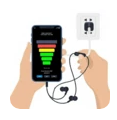In an era where smartphones have evolved into multipurpose tools capable of replacing numerous specialized devices, innovative applications continue pushing the boundaries of what mobile technology can accomplish. Voltage Detector By Headset represents a remarkable example of creative engineering that transforms ordinary audio equipment into functional electrical detection tools. This groundbreaking application demonstrates how software ingenuity can leverage existing hardware components in unexpected ways, providing users with practical utility previously requiring dedicated electrical testing equipment. By converting standard headset microphones into current-sensing instruments, the platform democratizes access to basic electrical detection capabilities that enhance safety and convenience for countless everyday situations.
Understanding Voltage Detector By Headset and Its Core Innovation
Voltage Detector By Headset embodies an elegant solution to a common practical challenge: detecting the presence of electrical current without investing in expensive specialized equipment. The application's fundamental innovation lies in exploiting the electromagnetic interference that alternating current generates in nearby electronic components. When electrical current flows through wires, it creates electromagnetic fields that induce subtle interference patterns in sensitive electronic devices positioned nearby. Headset microphones, designed to capture minute acoustic vibrations, prove surprisingly responsive to these electromagnetic disturbances when properly calibrated and processed through sophisticated signal analysis algorithms.
The technical principles underlying Voltage Detector By Headset relate to electromagnetic induction and interference detection rather than direct voltage measurement. Unlike precision multimeters that make physical electrical contact to measure voltage accurately, this application operates through non-contact detection of electromagnetic fields surrounding current-carrying conductors. This distinction proves crucial for understanding both the capabilities and limitations inherent in the approach. While the tool cannot provide precise voltage readings or replace professional electrical testing equipment for critical applications, it offers remarkable utility for approximate detection scenarios where users simply need to verify whether wires carry current.
Developer Badea Alhadhifi created Voltage Detector By Headset with the vision of making basic electrical detection accessible to anyone possessing a smartphone and standard headset. This democratization philosophy recognizes that many electrical detection needs don't require professional-grade precision but simply need reliable indication of current presence. Homeowners troubleshooting light switches, DIY enthusiasts working on electronics projects, and individuals verifying whether outlets carry power all benefit from accessible detection capabilities without purchasing dedicated voltage testers that might see infrequent use.
Comprehensive Feature Set and Operational Capabilities
Voltage Detector By Headset incorporates thoughtfully designed features that maximize detection reliability while accommodating diverse usage scenarios and equipment variations. The core detection functionality transforms headset microphones into electromagnetic field sensors through sophisticated signal processing algorithms that filter environmental noise, identify characteristic electromagnetic interference patterns, and translate detected signals into user-friendly visual feedback. This transformation requires substantial computational processing that analyzes audio input streams in real-time, applying pattern recognition techniques that distinguish electromagnetic interference from acoustic noise.
The intelligent calibration system represents a critical feature ensuring consistent performance across varying environmental conditions and equipment configurations. Electromagnetic background noise varies significantly between locations depending on nearby electrical infrastructure, active appliances, and other current-carrying systems. The automatic calibration process establishes baseline interference levels specific to each testing environment, enabling the application to distinguish between ambient electromagnetic noise and targeted detection of specific wires or devices under investigation. This environmental adaptation proves essential for reliable detection that minimizes false positives from background interference.
Voltage Detector By Headset offers three distinct sensitivity levels—low, medium, and high—providing flexibility that accommodates different headset microphone characteristics and detection requirements. Low sensitivity settings prove appropriate for high-quality microphones in environments with minimal electromagnetic background noise, reducing false triggering from distant current sources. Medium sensitivity offers balanced performance suitable for typical usage scenarios with standard consumer headsets. High sensitivity maximizes detection range and responsiveness for less sensitive microphones or situations requiring detection of weaker electromagnetic fields, though this increased sensitivity raises susceptibility to background interference requiring careful interpretation.
The live visual feedback system within Voltage Detector By Headset communicates detection results through interactive light indicators that provide intuitive, immediate understanding of electromagnetic field strength. As users move headset microphones closer to current-carrying wires, the visual indicators respond in real-time, displaying increasing intensity that confirms detection. This dynamic feedback enables precise localization of current-carrying conductors within walls, identification of specific wires within cable bundles, or verification that particular circuits carry power. The visual representation transforms abstract electromagnetic field measurements into concrete, actionable information accessible without technical training.
Practical Applications and Usage Scenarios
Voltage Detector By Headset serves numerous practical applications spanning household troubleshooting, DIY projects, electrical safety verification, and general curiosity about electrical infrastructure. Homeowners utilize the tool when troubleshooting lighting circuits, verifying whether problematic outlets receive power, or identifying which circuit breakers control specific electrical branches. The non-contact detection method provides crucial safety advantages since users never make direct electrical contact during testing, eliminating shock risks associated with probe-based voltage testers used incorrectly.
DIY electronics enthusiasts employ Voltage Detector By Headset when working with projects involving alternating current, verifying that components receive expected power or confirming that disconnected wires truly carry no voltage before handling them. The accessibility and convenience of smartphone-based detection encourage more frequent verification checks compared to scenarios requiring dedicated test equipment retrieval from storage, potentially preventing dangerous mistakes from assumptions about circuit states.
The application also provides educational value for individuals learning about electricity and electromagnetic phenomena. Students can visualize electromagnetic field distribution around various electrical devices, observing how field strength varies with distance and understanding practical implications of electromagnetic induction. This hands-on experimentation builds intuitive understanding that complements theoretical instruction about electrical principles.
Professional electricians might even find occasional utility in Voltage Detector By Headset as a supplementary tool for quick preliminary checks, though they would naturally rely on professional-grade equipment for definitive measurements and safety-critical verifications. The convenience of always-available smartphone-based detection provides value even to professionals with access to superior dedicated tools.
Operational Methodology and Best Practices
Successful operation of Voltage Detector By Headset requires understanding proper usage methodology that maximizes detection reliability while recognizing the tool's inherent limitations. The prescribed operational sequence begins with connecting a headset equipped with functional microphone to the smartphone running the application. Headset quality significantly impacts detection performance since microphone sensitivity, shielding quality, and electronic characteristics vary substantially across consumer audio products. Higher-quality headsets with sensitive microphones generally provide superior detection capabilities, though even basic equipment delivers useful results for many applications.
The crucial calibration phase requires users to position headsets away from electrical wires and active devices for approximately ten seconds while the application establishes baseline electromagnetic interference levels. This calibration period allows sophisticated algorithms to characterize ambient electromagnetic noise unique to the current environment, creating reference signatures against which subsequent measurements will be compared. Users should remain relatively stationary during calibration and avoid moving headsets unnecessarily to ensure accurate baseline establishment.
Following successful calibration, users can begin detection by slowly moving headset microphones toward wires or devices under investigation. Gradual approach enables observation of how visual indicators respond to increasing electromagnetic field strength, providing confirmation that detected signals correlate with proximity to the target rather than representing spurious interference. Users should experiment with different sensitivity levels if initial results seem unclear, adjusting settings to optimize the balance between detection responsiveness and false positive suppression for their specific equipment and environment.
Understanding that Voltage Detector By Headset provides approximate detection rather than precision measurement remains essential for appropriate tool utilization. The application reliably indicates current presence but cannot quantify exact voltage levels, distinguish between different voltage magnitudes beyond broad categories, or replace professional-grade testing equipment for applications requiring accurate measurements. Users must never rely solely on this tool for safety-critical verifications where electrical contact risks exist, instead using it as a preliminary screening tool supplementing rather than replacing proper safety procedures and professional equipment when warranted.
Technical Architecture and Signal Processing
The sophisticated signal processing algorithms underlying Voltage Detector By Headset represent the true technical achievement enabling practical functionality. Raw audio input from headset microphones contains complex mixtures of acoustic sound, electronic noise, and electromagnetic interference requiring advanced filtering and pattern recognition for meaningful interpretation. The application likely employs frequency domain analysis techniques that identify characteristic spectral signatures of electromagnetic interference from alternating current, which typically exhibits strong components at power line frequencies and their harmonics.
Machine learning algorithms may contribute to detection reliability by training on patterns characteristic of electromagnetic interference versus other signal types, improving discrimination accuracy through exposure to diverse scenarios. Adaptive filtering continuously updates in response to changing environmental conditions, maintaining detection performance as background interference levels fluctuate throughout testing sessions. Real-time processing requirements demand efficient algorithms that analyze audio streams with minimal latency, providing immediate visual feedback synchronizing with microphone positioning.
Multilingual Accessibility and Global Reach
Supporting 46 languages including English, Voltage Detector By Headset demonstrates commitment to global accessibility that ensures language barriers never prevent users from accessing valuable detection capabilities. The multilingual interface provides complete localization encompassing instructions, settings descriptions, and operational guidance, enabling confident usage regardless of English proficiency. This linguistic inclusivity expands the application's potential impact across diverse international markets where electrical detection needs exist universally but language support often limits software accessibility.
Safety Considerations and Responsible Usage
While Voltage Detector By Headset provides valuable detection capabilities, responsible usage requires understanding appropriate applications and safety limitations. The tool should never substitute for proper safety procedures when working with electrical systems, including circuit de-energization, lockout-tagout protocols, and verification testing with appropriate professional equipment. Users must recognize that detection limitations could potentially lead to dangerous assumptions if results are misinterpreted or over-relied upon without proper contextual understanding.
The application explicitly disclaims precision measurement capabilities, appropriately setting user expectations about functionality boundaries. This transparent communication helps prevent misuse scenarios where individuals might inappropriately substitute smartphone-based detection for professional testing equipment in contexts requiring accurate measurements or safety-critical verifications. Educational messaging within the application interface reinforces safe electrical work practices and encourages professional consultation for complex projects beyond user expertise levels.
Platform Requirements and Technical Compatibility
Voltage Detector By Headset operates on Android devices running version 7.0 or higher, ensuring broad compatibility across contemporary smartphones and tablets. The modest system requirements enable installation on older devices remaining in service, democratizing access without forcing users to upgrade hardware for application compatibility. Version 1.0 represents the foundation release establishing core functionality, with potential future updates likely refining detection algorithms, expanding features, or enhancing user interfaces based on community feedback and evolving understanding of optimal detection methodologies.
Conclusion: Democratizing Electrical Detection Through Innovation
Voltage Detector By Headset exemplifies how creative software engineering can extract unexpected utility from existing hardware, transforming consumer electronics into functional specialized tools. By leveraging electromagnetic interference detection through standard headset microphones, the application provides accessible electrical current detection capabilities to anyone possessing smartphone technology. While recognizing inherent limitations compared to professional electrical testing equipment, the tool delivers genuine practical value across numerous everyday scenarios where approximate detection suffices. As mobile technology continues evolving and developers discover innovative applications for standard components, platforms like Voltage Detector By Headset demonstrate the remarkable potential for smartphones to serve as versatile multipurpose tools enhancing convenience, safety, and capability across countless domains of human activity.









